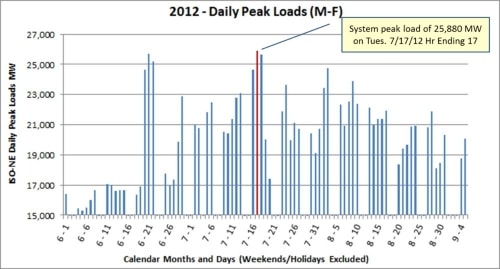September 25, 2015
Distributed Resilient Storage for Utility Capacity Shaving: A Use Case
By Todd Olinsky-Paul
Earlier this month, I had the pleasure of attending the commissioning of a solar+storage powered microgrid in Rutland, Vermont. The microgrid, which is owned and operated by the vertically integrated utility Green Mountain Power (GMP), includes 4 MW of battery storage (2 MW lithium ion + 2 MW advanced lead acid), 2.5 MW of solar PV, and 2 MW inverters. It was partly funded through a state solicitation, which resulted in a joint federal/state award from VT Public Service Department and US DOE, Office of Electricity; and in addition to helping GMP integrate a whole lot of solar (Rutland, VT recently became the “solar capital of New England,” with more PV per capita than any other city in the region), the system will provide resilient power to a school designated as a community emergency shelter – important in an area that was devastated by Tropical Storm Irene, and where grid outages are all too frequent.
GMP intends to put the $12 million microgrid to its best use. They will test out a number of use cases, but at the top of the list, in terms of economic returns, is reducing the utility’s peak capacity payments to the New England ISO.
The concept is very similar to demand charge management. Essentially, GMP pays millions each year to the grid operator for its share of capacity costs (the money paid to peaker plants to make sure they are available during peak load periods). GMP’s share of this cost is calculated based on their demand during one annual peak hour. In addition, there are 12 monthly peaks on which GMP’s portion of a transmission charge is calculated. Currently, GMP’s annual obligation is $80-90 million/year, based on one annual capacity peak ($30 – $40 million/year) and 12 monthly transmission peaks ($50 – $60 million/year). However, both of these rates are rising, with the capacity rate set to triple by 2018. By that time, GMP calculates it will be paying $150 million annually to the ISO.
Obviously, anything the utility can do to reduce its demand during these 13 hours out of the year could save it, and its ratepayers, quite a lot of money. In fact, GMP has said it values the microgrid at about $1 million per megawatt per year, half of which will come from using the batteries for capacity peak shaving and frequency regulation alone (the other half is based on income from the solar portion of the microgrid, including RECs and the value of electricity generated). Given this valuation, GMP is looking at a payback period of 5-10 years, and likely closer to the low end of that range.
To put this into context, the 4 MW of batteries on-site cost about $5-$6 million, and should achieve payback in just a few years.
But this is only the beginning for GMP. The utility has partnered with Tesla, and plans to install an additional 1 MW of Tesla Powerwall batteries at customer sites, beginning this fall. GMP will offer customers two business models:
- Utility-owned option – utility owns and operates distributed behind-the-meter storage, customer pays a monthly fee for backup services
- Customer-owned option, with contractual utility control during demand peaks in exchange for a bill credit
In both cases the customer gets a resilient power benefit. If this is successful, GMP intends to quickly increase distributed storage capacity beyond the initial 1 MW level.
To summarize, GMP is piloting three business models for resilient energy storage in Rutland:
- Centralized utility-owned or merchant-owned storage (economic benefit to utility, little or no resiliency benefit)
- Distributed utility-owned storage, customers purchase resiliency services (economic benefits to utility, resiliency benefit to customer)
- Distributed customer-owned (or third-party owned) storage, utility purchases demand response services (economic benefits to utility and customer, resiliency benefit to customer)
In considering these three models, it seems that the third offers a number of advantages as a replicable model. It works in regulated or deregulated electricity markets; engages the greater resources of the utility or load-serving entity (LSE) in deploying distributed storage; benefits the LSE, the participating customer, and ratepayers at large (who end up paying for capacity); encourages the deployment of larger amounts of distributed storage, which can provide more resiliency, since from the LSE’s POV, there is no diminishing return for deploying larger systems; and rewards early adopters, since they will benefit the most. From the customer’s POV, this looks like a simple demand response program run by their utility.
GMP is not the only utility to see the value of customer-sited energy storage systems. Similar plans have been proposed by a number of utilities from SDG&E and Southern California Edison in California to the Glasgow Electric Plant Board in Kentucky to APS in Arizona. And a recent survey of electrical utilities by Black & Veatch found that over 74 percent of utilities are looking to incorporate distributed behind-the-meter resources, such as solar PV and storage, into their business model. These utilities see solar+storage as a key technology for operational demand response, and they identified renewables combined with battery storage as the demand response technology that will have the greatest impact on their business going forward.
What can states do to turn this economic model into a resiliency model?
- Create a list of eligible critical facilities (schools/shelters, firehouses, water/wastewater treatment plants, fueling stations, communications hubs, transportation hubs, etc.)
- Define resiliency in terms of duration of islanded critical load
- Work with utilities/LSEs and third-party solar+storage providers to create customer programs
- Create a state incentive (prescriptive rebate?) for distributed resilient power systems at eligible facilities. The function of the state incentive is to direct storage to critical facilities that serve public functions.
Ideally, utility investment + state incentive + energy cost savings should equal low/no upfront costs + fast payback + economic benefits to the customer.
Resiliency should be free.















